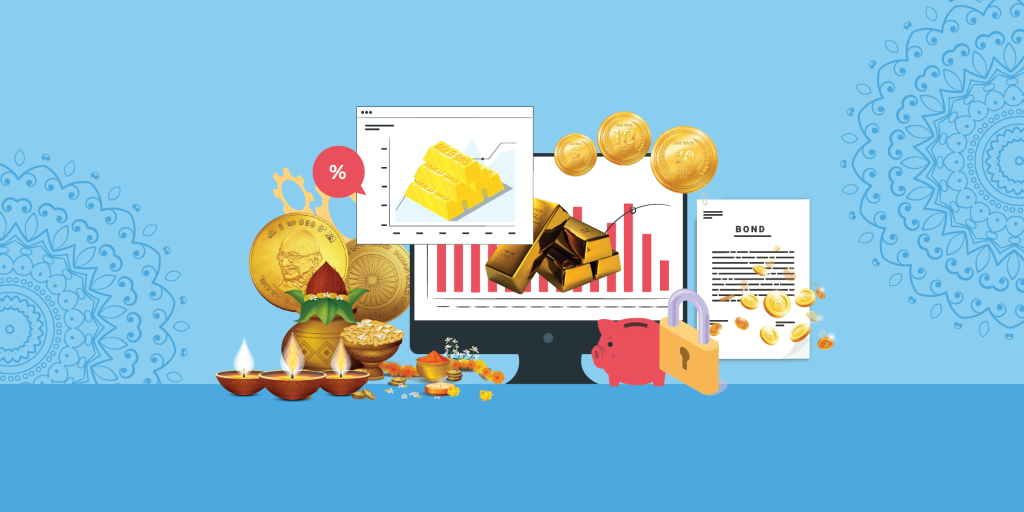Last Updated on Jan 4, 2023 by Aradhana Gotur
Since time immemorial, gold has secured a special place in Indian households, thanks to its financial, emotional, and social values. From a cultural point of view, many households in India follow the tradition of buying gold during Dhanteras and Diwali as it is considered auspicious. But from an investment perspective, gold is considered to be a safe haven as its value tends to increase when the stock markets are in turmoil.
As is evident, buying gold in the jewellery form and investing in the yellow metal has two different purposes. The first gives an emotional fulfilment and the second helps you secure your finances. So, this festival, choose to invest in alternate forms of gold to secure your finances rather than spending on jewellery alone. The common benefits these offer are cost-effectiveness and safety.
Here are 5 better ways in which you can invest in the yellow metal.
Table of Contents
1. Gold ETFs
Gold exchange-traded funds (Gold ETFs) are like mutual funds but can only be traded on stock exchanges via a demat account. Though these attract broker charges and management fees, Gold ETF’s eliminate storage costs and risk of theft. Moreover, Gold ETFs are priced transparently as they are benchmarked against physical gold. Ergo, the price of Gold ETF moves more or less in line with the underlying asset.
However, there is room for a difference in the prices of the Gold ETF compared to that of the physical metal due to the tracking error, which is mostly a result of expense ratio. To know more about ETFs, expense ratio, and how to choose a fund that fits your portfolio, read our 4-point checklist to pick an ETF article.
2. Sovereign Gold Bonds (SGB)
Sovereign Gold Bond is like owning paper gold. These bonds are issued by the government and are only available to transact during a window period for sale, which is typically open once in 2 to 3 months for about a week. But if you can’t wait and wish to buy SGB outside the window-period, you can simply purchase the older issues of the bond listed in the secondary market.
3. Gold savings schemes
This works like a recurring deposit or SIP and is offered by jewellers. A gold savings scheme requires you to deposit a fixed amount every month for a pre-determined tenure. At the end of the term, the jeweller adds a bonus, which is typically equal to one month’s instalment, on his behalf to your accumulated funds.
You can then use the total amount to buy gold at their store at prevailing rates. Sometimes, the jeweller may not add a bonus but may simply offer a gift item. Investing in a gold savings scheme is a good way to buy gold if you don’t have a lump sum but are willing to set aside a fixed amount monthly so you can save to purchase gold at a future date.
4. Gold coin scheme
The Indian Gold Coin Scheme is the first national gold offering launched by the government in 2015. The coins under this scheme are hallmarked as per the BIS standards and are available in the denomination of 5 gm, 10 gm, and 20 gm at recognised jewellers, banks, NBFCs, and e-commerce sites. These coins feature the National Emblem of Ashok Chakra engraved on one side and Mahatma Gandhi on the other.
Indian Gold Coins have 24 karat purity and 999 fineness and are linked to the international price of the yellow metal. The coins also possess advanced anti-counterfeit features, which avoids duplication, and tamper-proof packaging. What’s more, you can also liquidate these coins easily via MMTC’s ‘buy back’ option at their stores across India at the prevailing base rate.
5. Digital gold
Digital Gold is offered by the joint-venture of MMTC and Switzerland’s PAMP SA. The product is available online in the form of coins, bars, and jewellery. Digital Gold is offered by various mobile wallet companies and financial services providers in India, who store it in a fully-secured vault for safety.
The storage charges depend on the party offering the Digital Gold. For instance, MAMP charges zero storage fees but requires you to either convert the Digital Gold into coins or sell it after 5 yrs.
No investment comes without risk and/or charges. Likewise, investing in gold, be it in any form, also has certain costs or risks associated with it. For instance, while physical gold comes with storage costs and risk of theft, Gold ETFs have management fees and tracking error. Nonetheless, avoiding such risks and costs or keeping them to a minimum is a good thing to do anytime.
- Best Performing Index Funds in India (2025) - Jun 5, 2025
- Issue of Shares – Meaning, Types, Examples and Steps - Jun 4, 2025
- Banking Mergers in India – List of Merged PSU Banks, Advantages, and Challenges - Jun 3, 2025





